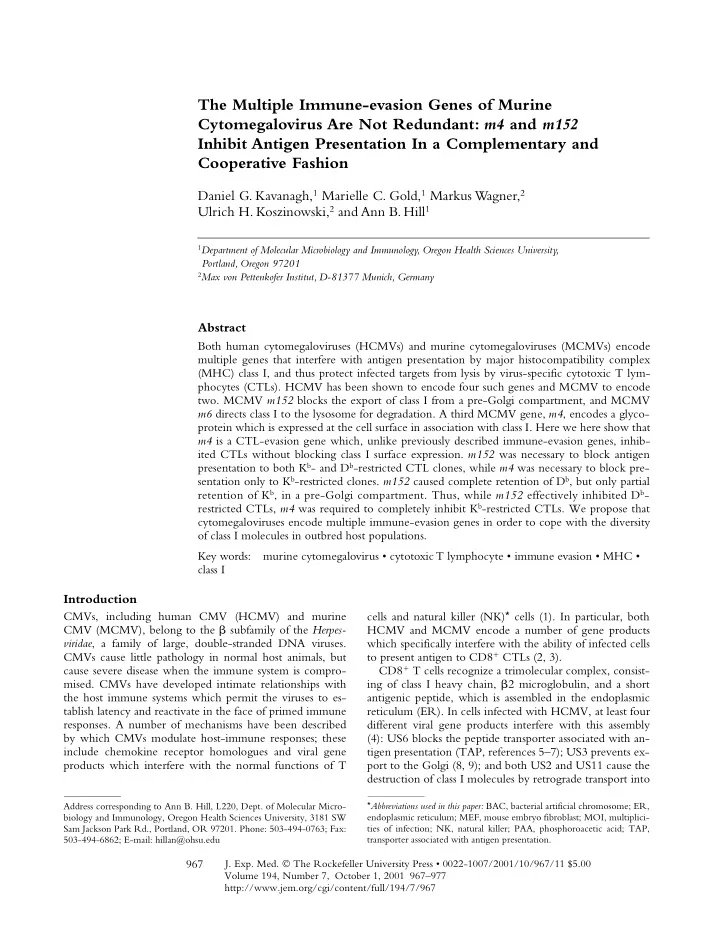

The Multiple Immune-evasion Genes of Murine Cytomegalovirus Are Not Redundant: m4 and m152 Inhibit Antigen Presentation In a Complementary and Cooperative Fashion 1 1 2 Daniel G. Kavanagh, Marielle C. Gold, Markus Wagner, 2 1 Ulrich H. Koszinowski, and Ann B. Hill 1 Department of Molecular Microbiology and Immunology, Oregon Health Sciences University, Portland, Oregon 97201 2 Max von Pettenkofer Institut, D-81377 Munich, Germany Abstract Both human cytomegaloviruses (HCMVs) and murine cytomegaloviruses (MCMVs) encode multiple genes that interfere with antigen presentation by major histocompatibility complex (MHC) class I, and thus protect infected targets from lysis by virus-specific cytotoxic T lym- phocytes (CTLs). HCMV has been shown to encode four such genes and MCMV to encode two. MCMV m152 blocks the export of class I from a pre-Golgi compartment, and MCMV m6 directs class I to the lysosome for degradation. A third MCMV gene, m4 , encodes a glyco- protein which is expressed at the cell surface in association with class I. Here we here show that m4 is a CTL-evasion gene which, unlike previously described immune-evasion genes, inhib- ited CTLs without blocking class I surface expression. m152 was necessary to block antigen presentation to both K b - and D b -restricted CTL clones, while m4 was necessary to block pre- b b sentation only to K -restricted clones. m152 caused complete retention of D , but only partial retention of K b , in a pre-Golgi compartment. Thus, while m152 effectively inhibited D b - b restricted CTLs, m4 was required to completely inhibit K -restricted CTLs. We propose that cytomegaloviruses encode multiple immune-evasion genes in order to cope with the diversity of class I molecules in outbred host populations. Key words: murine cytomegalovirus • cytotoxic T lymphocyte • immune evasion • MHC • class I Introduction CMVs, including human CMV (HCMV) and murine * cells and natural killer (NK) cells (1). In particular, both CMV (MCMV), belong to the � subfamily of the Herpes- HCMV and MCMV encode a number of gene products , a family of large, double-stranded DNA viruses. viridae which specifically interfere with the ability of infected cells � CMVs cause little pathology in normal host animals, but to present antigen to CD8 CTLs (2, 3). cause severe disease when the immune system is compro- � CD8 T cells recognize a trimolecular complex, consist- mised. CMVs have developed intimate relationships with ing of class I heavy chain, � 2 microglobulin, and a short the host immune systems which permit the viruses to es- antigenic peptide, which is assembled in the endoplasmic tablish latency and reactivate in the face of primed immune reticulum (ER). In cells infected with HCMV, at least four responses. A number of mechanisms have been described different viral gene products interfere with this assembly by which CMVs modulate host-immune responses; these (4): US6 blocks the peptide transporter associated with an- include chemokine receptor homologues and viral gene tigen presentation (TAP, references 5–7); US3 prevents ex- products which interfere with the normal functions of T port to the Golgi (8, 9); and both US2 and US11 cause the destruction of class I molecules by retrograde transport into * BAC, bacterial artificial chromosome; ER, Address corresponding to Ann B. Hill, L220, Dept. of Molecular Micro- Abbreviations used in this paper: biology and Immunology, Oregon Health Sciences University, 3181 SW endoplasmic reticulum; MEF, mouse embryo fibroblast; MOI, multiplici- ties of infection; NK, natural killer; PAA, phosphoroacetic acid; TAP, Sam Jackson Park Rd., Portland, OR 97201. Phone: 503-494-0763; Fax: 503-494-6862; E-mail: hillan@ohsu.edu transporter associated with antigen presentation. 967 J. Exp. Med. The Rockefeller University Press • 0022-1007/2001/10/967/11 $5.00 Volume 194, Number 7, October 1, 2001 967–977 http://www.jem.org/cgi/content/full/194/7/967
Recommend
More recommend